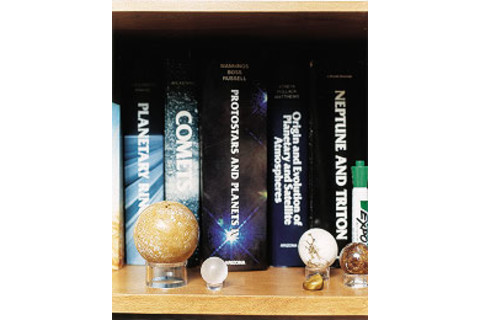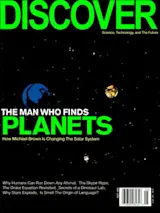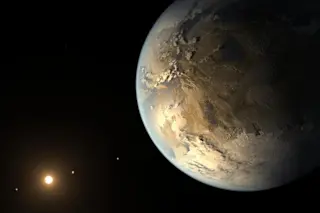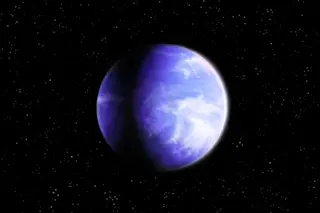Mike Brown grew up near NASA's Marshall Space Flight Center in Huntsville, Alabama, where his dad and every other dad in the neighborhood worked on Saturn rockets. Occasionally, the earth would rumble as he studied at his desk in a room dominated by a poster of the solar system. The shaking signaled yet another rocket test.
Decades later, Brown and his colleagues, Chad Trujillo of Gemini Observatory and David Rabinowitz of Yale University, have shaken the world of astronomy right down to that solar system poster, finding orbital objects as far as 10 billion miles from the sun in a ring of debris called the Kuiper belt. They nicknamed those icy bodies Quaoar, Sedna, Santa, Easter Bunny, and Xena.
The most important find is Sedna, which Brown calls a fossil that could lead to the unraveling of the history of the solar system. But the one that has caused the biggest uproar among astronomers is Xena, recently confirmed by a team of German scientists as being at least 30 percent larger than Pluto.
Xena prompted an ongoing debate in the International Astronomical Union as to whether it should be formally recognized as the 10th planet, or whether Pluto should be demoted and the number of planets reduced to eight. Whatever the decision, ultimately every elementary school science textbook will need to be rewritten and every solar system poster revised.
If you knew me as a first- or second-year graduate student in astronomy at the University of California at Berkeley, you're probably a little surprised to be reading about me now.
I didn't quite fit back then. I lived in a sailboat in the Berkeley marina and spent most of my time backpacking. Then came a big transformational moment. And the only reason I remember it being transformational is because afterward it happened again.
I went to the University of California's Lick Observatory with my academic adviser, and we were using this monstrous three-meter (120 inch) telescope. It was like a cathedral, actually, and a guy at the observatory mentioned this little telescope attached to the side of the big one. He said nobody used it because it was small and you couldn't really see much with it. I can still remember the feeling twisting in my stomach: That's wrong.
It's so hard to get time on a telescope. It's just wrong to have telescopes that don't get used. So I walked around for six months thinking there must be some way to take advantage of them all the time. It's completely backward from how anybody else figures out a Ph.D. project. Nobody finds a telescope and then, having no research topic in mind, spends a long time wondering what to do with it.
That telescope led me to study Io, one of the moons of Jupiter, focusing on its volcanoes and on how it interacts with Jupiter's magnetic field. For my Ph.D. thesis I used the telescope to observe Io for six months straight, watching volcanoes going off and then watching the changes.
But you know what that telescope really did? It made me very alert when the next transformational moment came along.
I was walking down the hall past the office next to mine—the office of a postdoc named Jane Luu—when I heard this urgent whisper: "C'mere!" Jane led me to her computer screen and showed me what she and Dave Jewitt had just discovered far beyond Pluto: the first Kuiper belt object.
This was 1992. It's funny now to think back on it. The day before, the Kuiper belt was thought of as a repository of comets that were maybe a kilometer across. This object was a couple of hundred kilometers across. The day before that discovery, the idea that there were large objects out there simply hadn't occurred to most people. And when it came time for me to think about what to do next, this was obviously the place to look.
My work on Io led me to Caltech, which is a fantastic place for an astronomer. But it was pretty different from what I was used to—that small telescope and a lot of access. At Caltech, you have access to really big telescopes—some of the greatest in the world—but for only a few nights a year. It makes a big difference in how you do astronomy, and to be honest, I felt uneasy. I liked the style that I'd used on Io and actually told my father I was thinking about leaving. He promptly responded that if I left Caltech I was a nut.
Just a few months later, I was using the big 200-inch Hale Telescope at Caltech's Palomar Observatory. It was a snowy night, and we couldn't view anything, so I headed off to the place where you can sleep. On the way, I ran into a staff member who wanted to show me the Samuel Oschin Telescope, a 48-inch instrument that had been used for 50 years to do the Palomar Observatory Sky Survey.
Astronomers all know the Palomar sky survey. It was huge. It took photographic plates everywhere across the sky, and these plates were reproduced on film and sent to every astronomy library in the world, which allowed anybody to get out a jewelers' loupe and look at whatever part of the sky he or she wished.
They were just about done with the second-generation survey, and this staff member told me that, basically, when the telescope finished there would be nothing else for it to do, and it was just going to sit there. I thought, "Oh, no, it's not!"

The spheres in Brown's office serve as both trophies and working models of his discoveries. They include, left to right, Xena and its moon; Santa; and Quaoar. | Misha Gravenor
It was instantly obvious that the Oschin was the telescope to use to find the largest Kuiper belt objects out there. The amount of sky that had been searched for these objects was insignificant. And the way to find these objects was to get a telescope that you could have access to a lot of the time and survey the whole sky.
I spent three years doing a huge survey using the 48-inch telescope and the type of photographic plates used for the Palomar sky survey. Each plate was a 14-inch square of glass with photographic emulsion painted on the back. You'd take it up to the telescope in the dark, load it with the lights out, expose it to the sky for about an hour, take it out, and drop it into a dumbwaiter that went down to the darkroom, where someone would do the developing. After all that, you'd have one picture of the sky on a piece of glass. Then the plates needed to be scanned and digitized so that the computer could look for things that were moving, and we no longer had to look by eye.
This led to three years of very intense effort. We found absolutely nothing, but it didn't matter. I knew that we had the chance to find something really big and significant out there.
The only reason we didn't find anything is that photographic plates can't pick up things as faint as what we can see today with new technology—and we got unlucky. Where we looked there was nothing, but if we had gone just five degrees south, we would've found Xena five years ago on those photographic plates.
In some ways, I'm glad we didn't. It would have been exciting, but it's been kind of fun to do the progression. It was so clear that there had to be large objects out there because people kept finding things a couple hundred kilometers across, and you can extrapolate. You never know if extrapolation is going to work, but we could extrapolate that there'd be a couple of things the size of Pluto or bigger.
We were obviously disappointed that the first three years didn't work out. Apparently, my tenure committee was a little worried about that too. But I wasn't. Not finding something is not a problem—it is still good science. What you need to do is go back, do very careful calibrations, and write a paper about not finding anything so that it's useful.
At that point we had already started working towards putting in the new system that we have now, which is a CCD camera that's very much like the small digital cameras everyone uses these days. The same objects that the photographic plates needed an hour to record could be seen in minutes by the digital camera. That's a huge difference and enabled us to cover a lot of sky. To give you an idea of the difference, three years of work with photographic plates could be done with the CCD in the course of roughly a month. And I could see things that were one-tenth as bright.
I realized that I had to make a big decision. I could either spend my time doing the calibrations of the old survey and write about why I didn't find anything, or I could put the old survey in the trash can and do it again with the new equipment.
"You have to write the old survey up," I was told, and I understood that. That's the obvious advice. I would give that same advice to almost anybody. But I knew it was the wrong advice. So I ignored it. Now you do that at your own peril.
We restarted the survey using CCDs just as the tenure process was moving ahead. By the time the committee had to make its decision, we hadn't found anything at all—well, a few small things, but nothing big.
Luckily, this wasn't the only thing I spent my time on. I'd done a few other things the committee was happy about. And as my division chair explained afterwards: "When it comes to tenure, everyone is looking for home runs. I had to argue that you had hit a lot of singles and doubles, which added up to one or two home runs."
A week after I was given tenure, we found Quaoar.
Quaoar is about half the size of Pluto. Everybody was really excited and wanted to hear about it. This was June of 2002. Now when I look back, it's "Hmmmm, Quaoar was big, but not that big compared to what came afterward."
Sedna was completely unexpected. It's 8 billion miles from the sun—Pluto is 3.6 billion—and in 2004 we had no idea that things in that very outer region of the solar system existed. The fact that they do is going to tell us an incredible amount about the birth of the sun and the earliest history of the solar system.
Sedna shouldn't be there. There's no way to put Sedna where it is. It never comes close enough to be affected by the sun, but it never goes far enough away from the sun to be affected by other stars, which is the case with comets that have been observed in the Kuiper belt. Sedna is stuck, frozen in place; there's no way to move it. And if there's no way to move it, basically there's no way to put it there—unless it formed there. But it's in a very elliptical orbit, and there's no way to form anything in an elliptical orbit like that. It simply can't be there. There's no possible way—except it is. So how, then?
I'm thinking it was placed there in the earliest history of the solar system. I'm thinking it could have gotten there if there used to be stars a lot closer than they are now and those stars affected Sedna on the outer part of its orbit and then later on moved away. So I call Sedna a fossil record of the earliest solar system. Eventually, when other fossil records are found, Sedna will help tell us how the sun formed and the number of stars that were close to the sun when it formed.
Sedna is incredibly far away, and we never would have seen it if it weren't as close as it gets on its orbit. In fact, there's about a 200-year period when we can see it, and it has a 12,000-year orbit. So what does that mean? If we see it for 200 years out of 12,000, that means there's only a 1 in 60 chance that we could've seen it, which means to me that there may be 60 of these things out there. And if there are 60 of these things, then there are probably 20 of these things just a little bigger and maybe a couple the size of Mercury or Mars. We're trying very hard to find the whole population. Once it's done, we'll be able to read the entire fossil record and learn incredible things.
Even though we went on to discover Xena, which is bigger than Pluto and could be called a planet, that is not particularly profound in and of itself. We've known all along that there was likely to be something bigger than Pluto out there, and we finally found it. Scientifically, without question, the most important object we've discovered is Sedna.
Clyde Tombaugh, who found Pluto in 1930, spent a decade or more going out to the telescope at night, taking these photographic plates, developing the plates in daytime, and looking through them. I've never really seen any of the things I find. By "see" I mean looking through a telescope and having photons actually hitting the eye. I don't even have to go to the telescope and do observations. The telescope takes pictures, and I see the pictures on a computer screen in my office. It's abstract and at the same time robotic.
The computer churns through most of the data, and I look through it for about 15 minutes every day. Now it's not like I don't do anything—to automate it like that took years of effort. But that's why it works and why I can actually have a wife and a life.
The very first time I saw Xena on my screen, I thought that there was something wrong. It was too big and too bright. I had to double-check where it was in the sky. Then I did a calculation of how big it was and how far away it was. Xena is the most distant object ever seen in orbit around the sun—10 billion miles away. And it turned out to be 1,800 miles in diameter, about 400 more than Pluto.
I grabbed the phone and called my wife. "I just found a planet," I said. She was pregnant at the time, and she replied: "That's nice, honey. Can you pick up some milk on your way home?"
Can I not talk about the Spaniards? I actually prefer to not mention them. These days I like to pretend like the whole thing never happened.
Well, OK, there's no denying they're part of the story. When we discovered the Kuiper belt object called Santa in December of '04, we went crazy—this was the brightest thing we'd ever seen. We didn't know how big it was at first, but we thought for reasonable and valid reasons that it was bigger than Pluto.
Less than three weeks later, in January of '05, we discovered Xena, which we knew was bigger than Pluto. It couldn't not be bigger than Pluto. And while we were studying these two in detail around Easter, we found another one, which we called Easter Bunny. It also looked like it might be bigger than Pluto, even though it wasn't. But at the time we thought we had three objects bigger than Pluto.
We were going to announce our discovery of Santa first because rumors had escaped. That way, everybody would think that Santa was the one the rumors were about and would be off our trail.
We were preparing to talk about it at a meeting in September in Cambridge, England. Then we'd announce the other two in October. There were three important reasons for this timetable. One, we wanted it to be during the school year because kids love this stuff. Two, we'd have time to prepare our scientific papers. You know, we actually like to do science on these things instead of just saying, "Oh, there's something out there!" And three, my wife gave birth on July 7, and I wanted to enjoy a little quiet time with her and the baby.
At the end of July, we went to an International Astronomical Union conference and talked about Santa, although we didn't say where it was, so there seemed to be no way you could find it.
But a few days later, on July 28, I got an e-mail from a guy working with us, who sent me an announcement on the discovery of an object and said, "Isn't this the object that you were talking about?"
It was. Somebody had found Santa. People in the International Astronomical Union were suspicious because the abstracts of our talk had gone on the Web. But when they asked me if I was suspicious, I naively told them no.
A few hours later I realized to my shock that we stupidly mentioned real codes that the computer spits out as soon as we find something. Santa was K40506A, which indicates that it was discovered in 2004 on May 6. The A means that it was the first object that we had found on that date. We had used K40506A to identify the object in our abstracts, and that was dumb. We should've just used the name Santa.
Turns out, unbeknownst to us, that if you went to Google and typed K40506A, you'd find yourself deep down in an inadvertently public archive of where one of our telescopes had been pointing. We didn't even know this archive existed, much less that you could actually get to it so easily from Google. Once you were there, you could figure out where we'd been looking.
The archive was not meant to be public. There was supposed to be one line of code in it to keep it private, but there was an error in that one line of code, and that made it available for the world to see.
Our Web server logs indicated that a computer at the Instituto de Astrofísica de Andalucia in Spain had visited. The same computer was used to e-mail an announcement claiming "the discovery."
As soon as we realized what happened, we knew it would be very easy to find the other objects the same way. It was impossible to keep the other two secret. It was Friday morning. When the sun went down that evening, anybody could point his telescope at the sky and say that he discovered the other two. So we had to announce their existence before sundown—the last Friday of July.
The space shuttle was up during that time, and they were trying to do repairs on the tiles. Every science reporter was at Johnson Space Center in Houston, but we called a press conference for four o'clock Pacific time Friday, which is the worst time to announce anything, and we had no scientific papers to back up our findings.
Our announcement was buried on page 18 of the Los Angeles Times. Nobody heard about it. The kids who love to find out about this stuff weren't even in school.
If the International Astronomical Union declares Xena to be a real planet, I hope there will be a chance for everyone to hear about it. But if they declare it not to be a planet, that's OK too.
The reason it doesn't matter to me is that if you start from scratch and do a scientific definition, the right number of planets is eight. As sad as I am for poor Xena, it's just not like the other eight. And Pluto is even smaller and less like the other eight. They're just not real, bona fide planets in the scientific sense.
But every time you find something, people get excited. When we found Quaoar, people were asking, "Is it a planet?" and we said: "No, no, it's not a planet. And, by the way, Pluto's not a planet either." Then we found Sedna. "Is it a planet, is it a planet?" "No, no, it's not a planet. And, by the way, Pluto's not a planet either." Same thing with Xena. Do we keep saying the same thing over and over? Or do we give up and realize that people just love Pluto?
Nobody wants to get rid of Pluto, and if you say that Pluto's not a planet—that it's just a crazy small thing out on the edge of the solar system—people look at you like you're a big cosmic bully.
The word planet is a word that lives in people's minds and imaginations. Pluto is a planet because for 75 years everybody's known that Pluto is a planet, not because there's a scientific reason.
Astronomers don't like that because they think they own the word planet, but the word has been around for 2,000 years, and it's never been a scientific word, and it doesn't need to be.
The analogy I use is the word continent. There's no scientific definition for the word continent. If you could come up with a scientific definition that encompasses the seven continents, I'd be impressed. Go ahead and try. Madagascar might be a continent because it's on a separate geological plate. Europe? No, definitely not—why is it separate from Asia? I have no idea. Australia? Sure. Maybe we'd make New Zealand one. New Zealand's got two plates. Anyway, you'd never hear geologists argue about this because they don't care. In geology, it doesn't matter whether society calls these things continents or not. They talk about what's there: continental crusts, continental dynamics, and so forth. I think astronomers should take that cue and say, let's be realistic—society wants labels on a small number of things we know about.
As scientists, of course, we need to know the difference between the eight things that are, let's say, major planets versus the minor planets. That way, we'll have good scientific names, just like geologists. And if people want to call Pluto a planet, let them call Pluto a planet.
But then you have to think about calling Xena a planet because it's bigger. So if the International Astronomical Union wants to call Xena the 10th planet and give it a formal name, that'll be fine by me too.
What do I do next? Well, if I'm still doing this down the road it means I'm stuck in a rut. Sometimes people can just go on forever doing something that gets increasingly less interesting. But I couldn't, even if I wanted to, because we've run out of sky.
There's a natural end to this survey. By this time next year—barring really bad weather—we'll basically have covered the entire sky that we can see. We'd like to do the other hemisphere, too, and that'll take another couple of years. But that'll be it. So that's a question I actually discuss with my students. What do we do next? A lot of people have this five-year plan—what they want to do and where they want to be. I have no idea.
Maybe I'm just waiting for somebody to tell me about some telescope that nobody happens to be using...
WHAT'S AT THE EDGE OF THE SOLAR SYSTEM?
Astronomers must grope in the dark for clues to the shape and makeup of the vast exturbs beyond Pluto

Xena, the "is/isn't" planet discovered by astronomer Mike Brown and his team, is the farthest object orbiting the sun that anyone has managed to find—roughly 10 billion miles out, more than 7 billion miles beyond Pluto. Yet Xena is nowhere close to the edge of our solar system.
The true outer limit is at least 500 times farther out, about 5 trillion miles beyond Pluto, where the sun looks like nothing more than a bright star and temperatures hover just a few degrees above absolute zero. Astronomers believe this region, called the Oort cloud, contains a vast collection of icy debris left over from material that came together to form the sun, Earth, and the other major planets 4.6 billion years ago.
Nothing in the Oort cloud is visible directly through telescopes, but astronomers infer its existence because it occasionally spits out objects that plunge toward the sun, where they sprout long, vaporous tails and become comets. About 10 comets from the farthest reaches of the solar system show up each year. Using mathematical models of the subtle forces that knock them loose—the tug of passing stars, interstellar gas clouds, and especially the gravitational fields of the galaxy itself—Harold Levison of the Southwest Research Institute in Boulder, Colorado, has estimated how many other objects populate the Oort cloud. "The total is about a trillion. It's a huge number, even bigger than our country's deficits," he says.
Most of these hidden objects are presumably irregular chunks of rock, ice, and frozen gases less than a mile across, Levison says. "But I'm sure there are also things Pluto-size, even moon-size or Mars-size out there." All the same, everything in the Oort cloud added together might not outweigh Earth. The most notable aspect of the region is its breathtaking emptiness. It is so vast that the average distance between objects is about as great as the span from Earth to the sun. The only dramatic action happens as passing stars stir things up every few million years or so, puffing the Oort cloud up like a bag of Jiffy Pop and stripping off its outer layer. Thus its population steadily declines over the eons.
The inner Oort cloud, which stretches from a few tens of billions of miles to a few hundreds of billions of miles from the sun, is much more stable than the edge of the region. If any objects orbit there—nobody knows—they would stay in place indefinitely. Brian Marsden of the Harvard-Smithsonian Center for Astrophysics speculates that there could be full-fledged Earth-size planets in this zone, circling unseen in the dark. "We would not have detected them observationally or dynamically," he says.
Today's best telescopes can penetrate only to the nearest part of the solar system's outer regions, known as the Kuiper belt. During the solar system's formative years, astronomers theorize, the region around Uranus and Neptune was full of icy bits of debris. As those giant outer planets grew, their powerful gravity flung much of that debris outward. The bits that migrated farthest scattered hither and yon, forming the Oort cloud. Material that stayed closer to the sun gave rise to the Kuiper belt.
The existence of the Kuiper belt was confirmed by direct observation in the early 1990s, when astronomers began to use high-sensitivity digital cameras and motion-sensing computer software to survey large areas of the sky. David Jewitt and Jane Luu of the University of Hawaii uncovered the first Kuiper belt object—a 100-mile-wide frozen ball known as QB1—in 1992. Then the floodgates opened: Astronomers quickly found more than 1,000 similar bodies, most of them about 4 billion miles from the sun, though a few orbit four or five times farther out. The best estimate is that the region contains 100 million objects at least a mile wide. Once again, the small fry dominate. Levison and his colleagues reckon that the combined mass of all the Kuiper belt objects is significantly less than that of the Oort cloud, perhaps a 10th or a 100th the weight of Earth.
Astronomers once pictured the Kuiper belt as a giant ring-shaped collection of bodies along a disklike plane, called the ecliptic, in which Earth and all the other major planets orbit. But wide-field surveys of the sky have yielded surprises. Most notably, Xena sits at a rakish 45-degree angle to the main planets, making a mockery of the old idea that the Kuiper belt is literally a belt. According to the latest thinking, Uranus and Neptune moved around as they formed, and smaller but still substantial bodies may have further stirred up the outer solar system in ways astronomers are still struggling to understand. For now, Brown and his fellow planet hunters have learned that they need to put old ideas aside and search in all directions for new worlds.
That ever-broadening search is about to get a huge boost from Pan-STARRS—the Panoramic Survey Telescope and Rapid Response System—a prototype of which will start up in Hawaii later this year. It uses four sets of optics and the world's largest digital camera to watch the entire sky for anything that moves, ranging from asteroids that stray dangerously close to Earth to unseen bodies in the Kuiper belt and beyond.
Pan-STARRS is a precursor to the much grander Large Synoptic Survey Telescope slated to begin operating in either Mexico or Chile in 2012. Using a mirror 28 feet wide—five times as big as the Pan-STARRS telescopes—and a camera the size of a pickup truck, it will be able to survey the entire sky in three days. Every 30 seconds it will gather 36 gigabytes of imagery, enough to fill 50 CDs. This digital cornucopia will most likely include a wealth of data about many thousands of Kuiper belt objects orbiting up to tens of billions of miles from the sun and almost certainly will include objects that once again contradict ideas about where the edge of the solar system is. "We've been wrong so many times before," Marsden says.
Meanwhile, astronomers will get close-up views of the outer solar system in July 2015, when the New Horizons spacecraft flies past Pluto and sends back detailed images of the once most-distant planet and its three moons. If all goes well, New Horizons will then continue on into the Kuiper belt. John Spencer, an astronomer at the Southwest Research Institute who is working on the New Horizons mission plan, has not even picked his targets yet; he is waiting for Pan-STARRS to give him a better road map.
What New Horizons sees may be the missing links that tie the solar system together, from here to the very edge. If Levison is right, the same scattering that created the Kuiper belt and built up the Oort cloud also bombarded the young Earth with comets, reshaping its surface and delivering the ices that helped create its oceans and atmosphere. When you take a big enough look at the solar system, Levison says, "it's all connected." -Corey S. Powell















